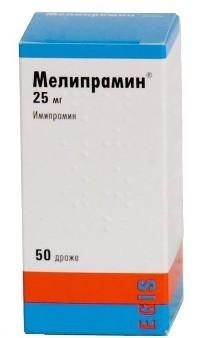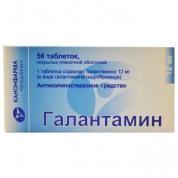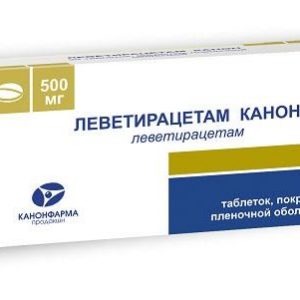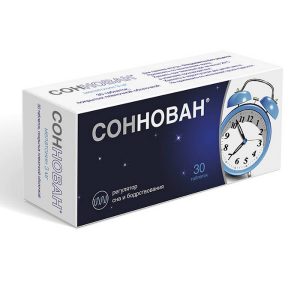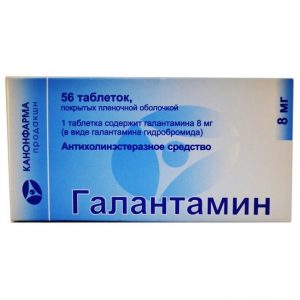Description
Release form
Solution for i / m administration is colorless or slightly colored (a greenish-yellow tint is possible), transparent, odorless.
Packaging
50 pcs
Indications
Depressions and depressive states of various etiologies, accompanied by motor and ideor retardation, depressive, asthenodepressive, endogenous, depressive, syndromes conditions with psychopathy and neurosis, nocturnal enuresis in children, behavioral disorders (activity and attention), panic disorders, chronic pain syndrome (chronic pain in cancer patients, migraine, rheumatic diseases, atypical facial pain, postherpetic neuralgia, post-traumatic neuropathy, diabetic or other peripheral neuropathy), narcolepsy, accompanied by catalepsy, bulimia nervosa, cocaine withdrawal syndrome, cocaine withdrawal syndrome urine (with tension and urge to urinate), headache, migraine (prevention).
Contraindications
Hypersensitivity, use together with MAO inhibitors and 2 weeks before the start of treatment, myocardial infarction (acute and subacute periods), acute intoxication with ethanol, hypnotics, narcotic analgesics, and other drugs that depress the central nervous system (CNS), which are oppressive to the open-hearted coronary gland (cardiac blockade of the bundle branch block, AV block II stage), lactation, children’s age (up to 6 years).
Special instructions
When prescribing Melipramine to patients with epilepsy, careful monitoring of the condition is necessary, because the drug can provoke an epileptic seizure in the first days of treatment.
When using the drug should pay attention that the therapeutic effect occurs no earlier than 1-3 weeks after the start of treatment, the maintenance dose should be taken for at least 3 months. In the initial period of treatment with Melipramin, constant medical supervision of patients with suicidal tendencies is necessary.
With a sudden cessation of the drug, withdrawal symptoms develop (nausea, headache, irritability, insomnia, arrhythmia and extrapyramidal disorders).
Do not use electroshock therapy while using Melipramine.
In the case of bipolar depression, the drug can provoke the patient’s transition to the manic phase.
In the early days of tricyclic antidepressants for treating a panic state, paradoxically increased psychomotor anxiety may occur. If this condition persists in 2 weeks, it is advisable to prescribe drugs – derivatives of benzodiazepine.
Use melipramine with caution in patients with a tendency to constipation.
Melipramine should be carefully prescribed for pheochromocytoma or acute porphyria because of the threat of exacerbation of diseases with the development of crisis.
Caution is advised to prescribe the drug to elderly patients and children, as in these groups of patients, serious side effects may develop.
During treatment with Melipramine, a systematic general blood test, assessment of liver function indicators, ECG monitoring and blood pressure levels are recommended.
Against the background of treatment with Melipramine, you should not drink alcoholic beverages.
Influence on the ability to drive vehicles and control mechanisms
During the use of Melipramin, it is forbidden to drive vehicles and perform other potentially dangerous work that requires an increased concentration of attention and speed of psychomotor reactions.
Composition of
imipramine hydrochloride 12.5 mg25 mg
Excipients: ascorbic acid, sodium disulfite, sodium sulfite anhydrous, sodium chloride (for parenteral dosage forms), water d / u.
Dosage and administration
Inside, during or immediately after a meal (to reduce irritation of the gastric mucosa), individual dose selection is necessary, for adults in an initial dose – 25-50 mg 3-4 times a day, then the dose is increased daily by 25 mg and brought to 200-250 mg / day, sometimes up to 300 mg / day, the duration of treatment for mild forms of depression is 4-6 weeks. After this, the dose is gradually reduced (by 25 mg every 2-3 days) and switched to maintenance therapy at a dose of 25 mg 1-4 times a day for another 4-6 weeks. In older people, the initial dose is 10 mg / day, with a gradual increase to 30-50 mg or more, until the optimal effect is obtained. To reduce the irritating effect on the gastric mucosa, it is recommended that you take it after eating. For maintenance therapy, a single dose is often used at night, fractional administration is left in the elderly, adolescents, and in patients with CCC diseases. The highest doses for adults inside: single – 100 mg, daily – 200 mg (outpatient), 300 mg (in a hospital) and 100 mg elderly patients. Children as an antidepressant, the initial dose – 10 mg over 10 days, the dose is gradually increased: for children aged 6-8 years – up to 20 mg, 8-14 years old – up to 20-25 mg, over 14 years old – up to 50 mg or more ( up to a maximum of 100 mg), in 2 divided doses. For bedwetting at the beginning of treatment, the daily dose: for children aged 6-8 years old – 25 mg, 9-12 years old – 25-50 mg, older than 12 years old – 50-75 mg, 1 time per day 1 hour before bedtime . In case of urinary incontinence, manifested in the early night hours, the daily dose can be prescribed in 2 doses: one half of the dose is taken in the middle of the day, and the other before bedtime. In the absence of effect, higher doses are prescribed after 1 week of treatment. A daily dose above 75 mg, as a rule, does not improve results. The highest daily dose for children is 2.5 mg / kg. In severe forms of depression in a hospital setting, you can use combination therapy – IM and oral. As an antidepressant, up to 100 mg / day in divided doses. Highest doses for adults: single – 50 mg, daily – 300 mg. Children under 12 years of age are not recommended. Stopping treatment too early can cause depression to resume. Imipramine should be discontinued gradually.
Side effects of the
From the side of the central nervous system and peripheral nervous system: headache, dizziness, excessive sedation, paresthesia, tremors, convulsions, dysarthria, coordination disorders, sleep disturbances, hallucinations, agitation, disturbance of accommodation.
From the digestive system: dry mouth, stomatitis, nausea, vomiting, constipation, intestinal obstruction rarely – hepatitis.
From the cardiovascular system: tachycardia, arrhythmia, orthostatic hypotension.
Urinary system: urinary retention.
From the hematopoietic system: leukocytosis, eosinophilia rarely – leukopenia, thrombocytopenia, agranulocytosis.
From the endocrine system: gynecomastia, galactorrhea, decreased libido, a change in blood glucose.
Allergic reactions: urticaria, exanthema, angioedema.
Other: photosensitization.
Drug Interactions
The simultaneous use of Melipramine and MAO inhibitors significantly increases the risk of excitation, seizures, fluctuations in blood pressure, hyperthermia, coma. After stopping the intake of MAO inhibitors, it is necessary to take a break 2-3 weeks before the appointment of Melipramine (and vice versa).
With the simultaneous use of Melipramine and m-anticholinergics, the anticholinergic action of drugs is summed.
With the simultaneous use of Melipramine and hormonal preparations of the thyroid gland, there is an increase in adrenergic effects, which can cause tachyarrhythmias and the development of angina attacks.
With the combined use of Melipramine with adrenergic agonists (epinephrine, norepinephrine, mesatone), the risk of tachycardia, arrhythmia and hypertension increases due to inhibition of the inactivation of catecholamines by Melipramine.
With the simultaneous use of Melipramine with alpha-adrenergic blocking agents and central -adrenoreceptor stimulants (clonidine, guanethidine, methyldopa), the antihypertensive effect of the latter decreases, which is possibly due to the inhibition of their binding to presynaptic -adrenoreceptors.
imipramine reduces the anticonvulsant effect of phenytoin.
central nervous system depressants, and ethanol increase the sedative effect of Melipramine, and benzodiazepine derivatives and phenothiazines enhance the sedative and anticholinergic effects of Melipramine.
Inhibitors of microsomal oxidation enzymes (cimetidine, methylphenidate, oral contraceptives) slow down the metabolism of imipramine and increase its half-life, and therefore increase the antidepressant effect and toxicity of the drug.
Overdose
Symptoms: psychomotor agitation, dry mouth, mydriasis, tachycardia, urinary retention, confusion, difficulty breathing, convulsions, coma.
Treatment: it is necessary to monitor the function of the cardiovascular and respiratory systems, conduct symptomatic therapy. In convulsions, diazepam, phenytoin, phenobarbital are injected into / into.
Imipramine is not dialysable. Forced diuresis is also ineffective.
Storage conditions
The product should be stored out of the reach of children, protected from light at 15 ° C to 25 ° C.
Shelf life
2 years.
Deystvuyushtee substance
Imipramine
Terms and conditions
prescription
dosage form
tablets
Possible product names
MELIPRAMINE 0.025 N50 MORE THAN
MELIPRAMINE 0.025 N50 TABLE S / N
Melipramine 25mg dr. N50
Melipramine 25mg Dr. X50 / until 11.2007 y. / B
Melipramine 25mg dr. X50 B (R)
